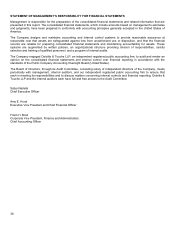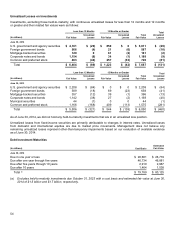Microsoft 2014 Annual Report Download - page 48
Download and view the complete annual report
Please find page 48 of the 2014 Microsoft annual report below. You can navigate through the pages in the report by either clicking on the pages listed below, or by using the keyword search tool below to find specific information within the annual report.47
Microsoft enters into arrangements that can include various combinations of software, services, and hardware. Where
elements are delivered over different periods of time, and when allowed under U.S. GAAP, revenue is allocated to the
respective elements based on their relative selling prices at the inception of the arrangement, and revenue is recognized
as each element is delivered. We use a hierarchy to determine the fair value to be used for allocating revenue to
elements: (i) vendor-specific objective evidence of fair value (“VSOE”), (ii) third-party evidence, and (iii) best estimate of
selling price (“ESP”). For software elements, we follow the industry specific software guidance which only allows for the
use of VSOE in establishing fair value. Generally, VSOE is the price charged when the deliverable is sold separately or
the price established by management for a product that is not yet sold if it is probable that the price will not change before
introduction into the marketplace. ESPs are established as best estimates of what the selling prices would be if the
deliverables were sold regularly on a stand-alone basis. Our process for determining ESPs requires judgment and
considers multiple factors that may vary over time depending upon the unique facts and circumstances related to each
deliverable.
Revenue for retail packaged products, products licensed to original equipment manufacturers (“OEMs”), and perpetual
licenses under certain volume licensing programs generally is recognized as products are shipped or made available.
Technology guarantee programs are accounted for as multiple-element arrangements as customers receive free or
significantly discounted rights to use upcoming new versions of a software product if they license existing versions of the
product during the eligibility period. Revenue is allocated between the existing product and the new product, and revenue
allocated to the new product is deferred until that version is delivered. The revenue allocation is based on the VSOE of fair
value of the products. The VSOE of fair value for upcoming new products are based on the price determined by
management having the relevant authority when the element is not yet sold separately, but is expected to be sold in the
near future at the price set by management.
Software updates that will be provided free of charge are evaluated on a case-by-case basis to determine whether they
meet the definition of an upgrade and create a multiple-element arrangement, which may require revenue to be deferred
and recognized when the upgrade is delivered, or if it is determined that implied post-contract customer support (“PCS”) is
being provided, the arrangement is accounted for as a multiple-element arrangement and all revenue from the
arrangement is deferred and recognized over the implied PCS term when the VSOE of fair value does not exist. If updates
are determined to not meet the definition of an upgrade, revenue is generally recognized as products are shipped or made
available.
Certain volume licensing arrangements include a perpetual license for current products combined with rights to receive
unspecified future versions of software products (“Software Assurance”), which we have determined are additional
software products and are therefore accounted for as subscriptions, with billings recorded as unearned revenue and
recognized as revenue ratably over the coverage period. Arrangements that include term-based licenses for current
products with the right to use unspecified future versions of the software during the coverage period, are also accounted
for as subscriptions, with revenue recognized ratably over the coverage period.
Revenue from cloud-based services arrangements that allow for the use of a hosted software product or service over a
contractually determined period of time without taking possession of software are accounted for as subscriptions with
billings recorded as unearned revenue and recognized as revenue ratably over the coverage period beginning on the date
the service is made available to customers. Revenue from cloud-based services arrangements that are provided on a
consumption basis (for example, the amount of storage used in a particular period) is recognized commensurate with the
customer utilization of such resources.
Some volume licensing arrangements include time-based subscriptions for cloud-based services and software offerings
that are accounted for as subscriptions. These arrangements are considered multiple-element arrangements. However,
because all elements are accounted for as subscriptions and have the same coverage period and delivery pattern, they
have the same revenue recognition timing.
Revenue related to phones, Surface, Xbox consoles, games published by us, and other hardware components is
generally recognized when ownership is transferred to the resellers or to end customers when selling directly through
Microsoft retail stores and online marketplaces. A portion of revenue may be deferred when these products are combined
with software elements, and/or services. Revenue related to licensing for games published by third parties for use on the
Xbox consoles is recognized when games are manufactured by the game publishers.
























